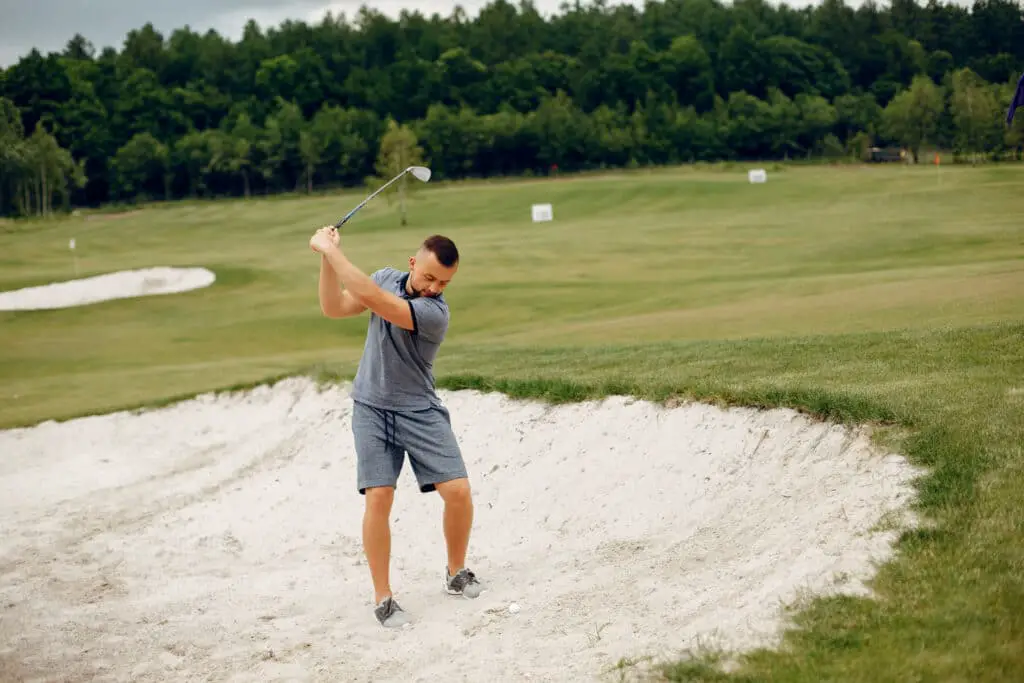Last Updated on June 7, 2023
Golf is one of the most popular sports in the world, and many amateur players strive to improve their game. One of the key elements that can make or break a golf swing is getting your weight distribution right. Knowing where should your weight be during a golf swing can help you develop better technique and form, resulting in increased accuracy and power when striking the ball. In this article, we will discuss how to find the perfect balance between power and control by understanding where your bodyweight should be throughout the golf swing. Read on for more insights into achieving success with your golf swings!
Have you ever noticed experienced players move seamlessly through their swings? It’s not just luck – it’s because they know exactly where their weight needs to be at all times. The position of your bodyweight changes as you transition from address to follow-through, so it’s important to understand what adjustments need to be made along each stage of your motion. With some practice and focus, you too, can learn how to master optimal weight placement for maximum efficiency!
The beauty of golf lies in its ability to adapt; no two swings are identical – but there are certain tips that every player should keep in mind if they want consistent results. We’ll look at why proper weight transfer matters, provide an overview of ideal positions throughout the swing and offer advice on drills that will help hone your skills like never before. So get ready – mastering these fundamentals could have a major impact on your overall performance!
The Role Of Body Weight
In a golf swing, the role of body weight is critical. To ensure proper alignment and mechanics, an efficient weight transfer and shift must occur. Weight should be shifted from the back foot to the front during the downswing while maintaining steady movement throughout. This will create momentum through the strike, which leads to greater power in the shot.
It is important to keep your head still as you move your weight forward; this allows for better control over the clubface at impact and, ultimately, more accuracy on shots. Furthermore, if too much weight is placed on either side of the body, it can lead to improper ball striking or even injury due to incorrect posture. Proper setup and technique are essential when considering where your body weight should be in a golf swing.
Proper Posture And Balance
It is important to have proper posture and balance during a golf swing. Having the right posture will help ensure your body alignment, weight balance, and overall stability throughout your swing. To start, keep your feet shoulder-width apart for balance and make sure you are standing with good posture. As you bend from the waist to address the ball, be sure to maintain a straight back position. Your arms should also hang freely at your sides as if there were no clubs in them; this allows for maximum flexibility of movement while swinging. Additionally, when taking the backswing, remember to evenly distribute your weight between both legs instead of shifting it onto one side or another. This helps create an even rotation through the hips, which produces consistent power in each shot. It’s also essential that you stay balanced on both feet throughout the entire swing until after impact has been made with the ball. Keeping these tips in mind can help ensure that you remain properly postured and balanced during a golf swing for optimal results.
Weight Distribution Between Legs
Now that you have established proper body posture and balance, it is time to focus on weight distribution between your legs. It is important for golfers to know how their weight should be used during a swing in order to maximize the power of their swings while maintaining stability.
Your weight should be evenly distributed between both legs throughout your entire swing, with an emphasis on keeping your feet firmly planted on the ground. This practice will help ensure that your upper body stays connected to the lower body and provides more stability as you make contact with the ball. As well as distributing your weight evenly between your legs, it’s also beneficial to engage stabilizing muscles in order to maintain proper form and good posture throughout the entire motion. Utilizing these techniques can significantly improve your swing dynamics and overall performance on the course.
By correctly utilizing the weight within our bodies, we can find a much smoother transition from address position into backswing, then down into impact and follow-through with increased accuracy and control over each shot taken. This type of control helps us take consistent shots when playing our round which ultimately leads us to lower scores.
Impact Of Clubhead Speed On Weight Transfer
Clubhead speed is an important factor in weight transfer during a golf swing. As the club head accelerates, body weight shifts to the target side of the body and away from the back foot. The faster the clubhead speed, the more dramatic this shift will be. Proper posture and balance are key components to achieving optimal weight transfer while swinging at high speeds.
Environmental conditions such as course terrain, wind direction, and temperature can also influence how much weight needs to be shifted for effective ball striking. Therefore, it is important to adjust your swings accordingly based on these varying factors. Understanding where your body weight should be when swinging with various clubhead speeds can greatly improve the accuracy and distance off of each shot.
Rotational Movements In The Golf Swing
The weight shift during the golf swing is an important factor that should not be overlooked. During the backswing, a golfer’s weight should gradually move to the right side while completing hip and shoulder rotation. This helps create torque in the body, which will later be used to hit the ball with power and accuracy. It also allows for a greater turn of the clubface angle at impact, resulting in more distance on shots.
At address position, it is essential for a golfer to keep most of their weight on their left side (for a right-handed golfer). As they initiate the takeaway phase of the swing, however, approximately 60% of their weight should shift towards their right foot until the completion of the backswing. By doing so, this ensures that all parts of your body are working together cohesively throughout each movement within your swing sequence and ultimately provide you with more control when hitting shots down range.
Stabilizing Muscles And Joints
The golf swing is a complex movement that relies on the coordination of both rotational and stabilizing motions. For successful execution, it’s important to understand how these two actions work together for optimal performance. Stabilizing muscles play an essential role in maintaining balance and providing stability throughout the entire golf swing. These muscles support joints during their motion as well as prevent excessive joint movement by controlling muscle stabilization.
Developing strength in stabilizing muscles allows them to be ready when they are needed most – at setup, during backswing, downswing, impact and follow through. During each phase, various joints will experience different degrees of motion and muscle activation depending on what type of shot is being performed. It’s important to develop the specific muscular control over all areas so that you can maintain proper alignment while targeting your desired area with precision and accuracy. By utilizing strong stabilizing muscles, you can achieve consistent results without sacrificing power or direction control due to faulty body mechanics or lack of focus.
Golfers must ensure that adequate attention is given to developing strength within stabilizing muscles and joints so that maximum performance potential can be achieved every time they step onto the course. With correct technique and physical conditioning, any golfer can improve their game drastically simply by focusing on optimizing the use of their bodies natural movements in order to gain precise accuracy with each hit.
Environmental Conditions Affecting Weight Distribution
The environment plays a major role in determining where the weight should be placed during a golf swing. Temperature, humidity, wind, and terrain all affect how much weight is distributed throughout the body.

When it’s warm outside, players will have to apply more pressure on their back foot for stability as they take their shot. This helps keep them balanced so that they can make solid contact with the ball and control its trajectory. In contrast, when it’s cold out, putting additional weight onto the front foot allows players to generate more power from their swings while keeping the balance at impact.
Humidity levels also cause fluctuations in where a player’s weight should be located. High humidity makes air heavier, which causes extra resistance against your club head during your swing, thus requiring more strength when driving or chipping shots. Lower humidity doesn’t offer such an obstacle but still demands proper form and stance because any misalignment could lead to inaccurate hits or slower speeds than normal due to a lack of support from the ground below.
Finally, wind and terrain are two other environmental factors that must be taken into account when deciding where to place one’s weight during a golf swing. Wind can push or pull your shot off course if you don’t adjust accordingly by leaning toward or away from the direction of gusts, depending on whether you’re swinging upwind or downwind, respectively. As for terrain, it often dictates what type of shot needs to be used based on obstacles like sand traps, water hazards, trees etc., that require special attention and adjustments in order to get around them effectively without losing distance in the process.
Factors To Consider When Deciding Where To Place Weight During A Golf Swing
- Weather:
- Temperature
- Humidity
- Environment:
- Wind
- Terrain
These conditions not only influence how far your shots travel but also dictate what stance would work best under certain circumstances in order to achieve optimal performance and accuracy no matter what lies ahead.
Conclusion
In conclusion, weight transfer during a golf swing is key to improving your game and achieving the desired results. To ensure proper weight transfer, it’s important to practice with the correct form and technique. Start by positioning your hands and arms in the right place and keep them there throughout the entire swing. Make sure you stay balanced as well; this can be done by using equipment such as weighted clubs or special shoes designed for golfing purposes.



